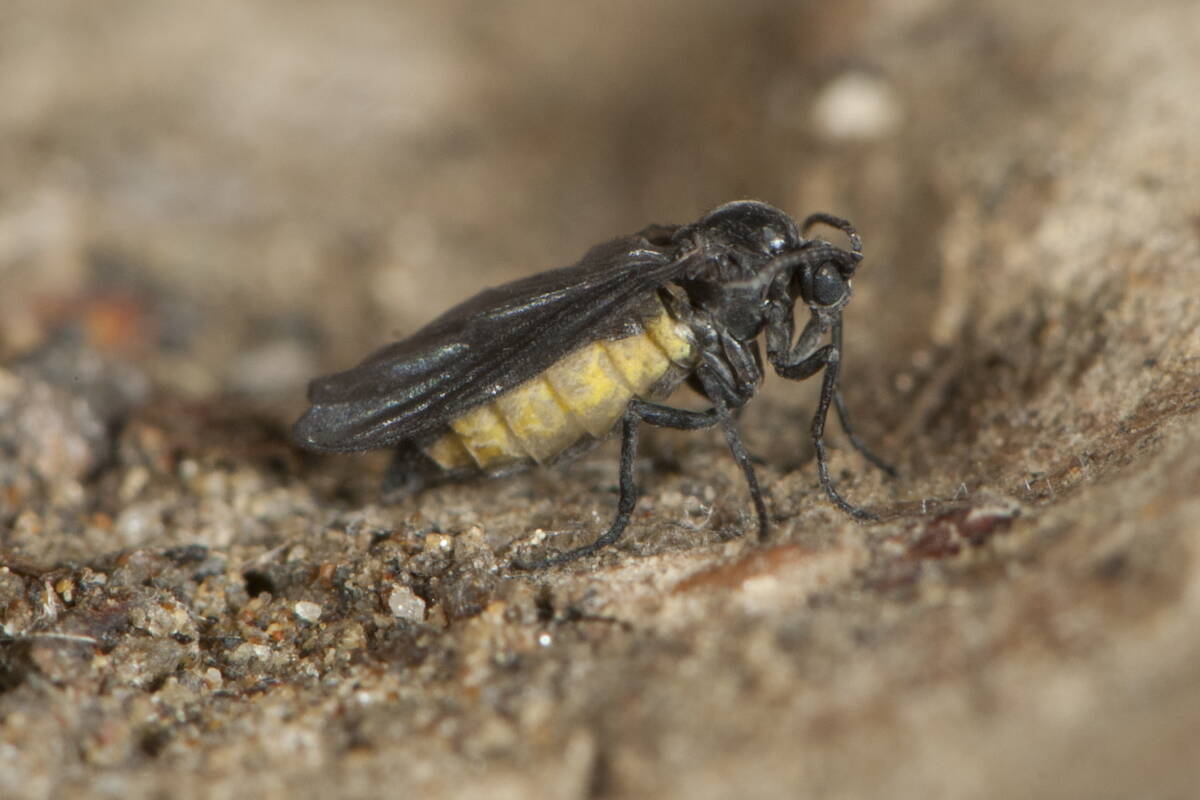Add another species to the list of organisms oozing over Alaska.
A tiny gnat — one that in its larval stage sometimes crawls over its brethren’s backs in great numbers until together they resemble a long gray snake — is a newly described species.
Alaska insect expert Derek Sikes and postdoctoral researcher Thalles Pereira from Brazil, along with Kai Heller and Mitsuaki Sutou, recently co-authored a paper on the insect, one whose behavior had puzzled Sikes like no other.
The story started in 2007. That’s when Sikes, curator of the insect collection at the University of Alaska Museum of the North in Fairbanks, received a Ziploc full of translucent little worms, along with a few perplexing photos.
Maggie Billington of Ester handed the bag to Sikes. She described the bizarre procession of hundreds of the mysterious larvae she saw crawling over one another, stretched out like a garden hose.
“I figured they must be fly larvae but had never heard of this snakeworm phenomenon,” Sikes said. “I was dumbfounded. This was totally an X-Files case for me.”
Unfortunately, the tiny worms in the Ziploc had all perished. Sikes needed to eyeball an adult in order to identify the mystery insect.
But he got a second chance. During that same summer of 2007, Sikes received a call from Diane Claassen, a University of Alaska Fairbanks Cooperative Extension Service agent.
“There is a column of these things crossing Pika Road right now,” she said.
Sikes set down his coffee cup and zipped out the door.
He drove a few miles from his office to Pika Road in Fairbanks. The larval parade was still ongoing.
Sikes dropped to his knees to take photos. When he finished, he gently plucked a bunch of larvae — each the size of a grain of rice — and dropped them into a plastic container. Into that container, he sprinkled some fungus-gnat food, dead leaves from the adjacent forest.
Sikes then became an expectant insect-rearer, hoping the larvae would pupate and turn into flies.
A week later, to Sikes’ delight, a few flies emerged. They were black, a bit longer than fruit flies.
He contacted colleagues in Germany and Japan who are experts on that family of fungus gnats. They both thought the Alaska gnat was probably the same species that exists in Europe and also travels in long larval columns. But they were not sure.
The team sequenced DNA of the Alaska gnats. Results showed there was sufficient genetic divergence between the Alaska gnat and the European one to consider them separate species.
In 2021, Thalles Pereira from Brazil came to Fairbanks on a postdoctoral assignment to work with Sikes. Pereira examined the adult male Alaska gnats under extreme magnification. He found distinct differences in the shape of the insect’s genitalia when compared to the European one.
That was enough for the scientists to confirm the existence of a new species and properly describe it.
The creature needed a name. Sikes asked students in his summer bug camps which of three they preferred for the fungus gnat. They chose Sciara serpens for the insect’s occasional snakelike behavior. The species hasn’t yet been found outside Alaska.
So, why in the world would these tiny worms form themselves into living ropes?
Thalles and his co-authors think there may be two main reasons. The columns look like a snake, which might scare off or confuse birds and other predators. The gnat larvae also might move in columns to keep their fragile bodies moist when crossing dry ground.
The latter seems to be valid for the few observations of snakeworm gnats in Alaska, from Southwest Alaska to Fairbanks. Most of them were slithering across gravel roads and trails.
Finally, who needs a fungus gnat? Though gardeners aren’t fond of the ones that breed in moist, moldy soils and share our indoor living space, fungus gnats are important pollinators and recyclers of the decaying organic matter they eat. The ones that engage in the snakeworm behavior are not found indoors.
• Since the late 1970s, the University of Alaska Fairbanks’ Geophysical Institute has provided this column free in cooperation with the UAF research community. Ned Rozell ned.rozell@alaska.edu is a science writer for the Geophysical Institute.

